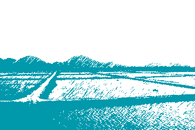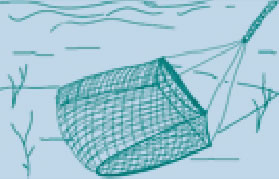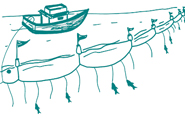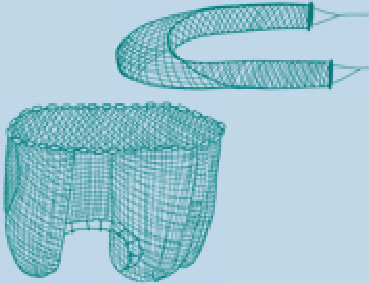The way a fish or shellfish is harvested may have a bearing on product quality. Aquaculture aside, there are literally thousands of ways of catching fish, but commercial supplies are mainly produced by some form of trawling, seining or gillnetting. All three of these industrial techniques use nets. Other commercial species are caught with hook and lines, while other fish are harpooned, trapped, or dredged.
The catching technique used may affect the quality of the fish. This is not a simple matter, and there are numerous considerations involved such as the species caught, the local air and water temperatures, when it was caught, and the physical condition of the fish. In general, catching technique has less of an affect on quality than does the way the fish is handled immediately after capture.
The way the fish is handled on the boat can be at least as important as the type of gear used to land it. Bleeding, careful handling and, above all, rapid and adequate icing, all contribute greatly to high quality product. Overall, it is better to pay attention to the quality of the product rather than making selections based on fishing methods.

|
AQUACULTUREFish farming is the fastest growing sector of the fishing industry and the great hope for the future of supplies of fish and shellfish. Fish farming has been an important activity in parts of Asia for many centuries and has now spread throughout Europe, Central & South America, as well as to the United States. Shrimp and salmon are the aquaculture headliners. These markets have been transformed by the availability of farmed product. In the United States, the majority of oysters, trout, crawfish and catfish harvested are all farmed. Many other seafood products are also being experimentally farmed. The importance of fish farming to the seafood buyer lies in the potential for reliable and consistent supply that is offered by farming techniques and the associated marketing advantage that consistent product brings. |

|
DREDGEA dredge is utilized for collecting molluscs, like clams, mussels and scallops, from the sea floor. The dredge has an open-ended metal frame where a holding bag, typically constructed of metal rings or mesh, is attached. The vessel drags the gear over the seabed digging the shellfish from the ground. The dredges are towed in a manner similar to beam trawlers. Large dredgers may work three or more dredges on each side. |

|
HARPOONThe harpoon will forever have its place in the history books, but today it is little more than a nostalgic method of landing fish. Some swordfish, shark, and tuna are still taken by harpoon, but the method has been rendered largely obsolete by longline methods. Harpoons can be deployed by hand or shot from a gun. |

|
GILLNETGillnets, or entangling nets, are strings of single, double or triple netting walls intended to remain stationary. The gillnet is one of the oldest types of stationary nets. They are deployed vertically, near the surface, in mid-water, or on the bottom. As the name implies, fish become entangled in these nets by their gills. Gillnets have floats on the upper line and weights on the bottom to keep the net in an upright position. There are two basic forms of the gillnet: the drift net and the set or anchor net. The latter is the only commercially important gillnet in the United States. The United Nations established a worldwide moratorium on all high seas drift net fishing effective December 31, 1992. The ban is in force in all the world's oceans, enclosed seas, and semi-enclosed seas but applies only to international waters, not to waters under national jurisdiction. Drift nets were designed for pelagic species like mackerel and salmon, typically in deep water. The more important set nets are more commonly found in the inshore fisheries and put out along the seafloor to catch groundfish. |

|
HOOK & LINELanding fish by hook and line has been practiced for centuries. In the hook and line method, fish are attracted by either a natural or artificial bait placed on a hook fixed to the end of a line on which fish get caught. This type of harvesting can be separated into four categories: hand lines, pole and lines, troll lines, and longlines or set lines. The hand line is primarily relegated to small, artisanal inshore fisheries. Both natural and artificial baits are used, and the lines are retrieved with hand reels. A pole and line features a hooked line attached to a rod and reel. This method is most commonly employed by sport fishermen, but it is also used commercially, where it is most prominent in catching tuna and mackerel-like fishes. A troll line utilizes lures or baited hooks, tracked by a vessel near the surface or at a certain depth. Trolling adds motion to the bait or lure being used. While trolling can be accomplished using as little as one line, modern fishermen usually employ several lines at the same time through the use of outriggers. The lines are typically hauled with small winches. A longline can be either a set or drifting longline. Both types consist of a main or ground line with a number of regularly spaced branch lines or snoods with baited hooks attached. A drifting longline is typically set near the surface and aided by regularly spaced floats while a set longline is usually deployed on or near the ocean floor. The number and size of hooks used, the space between, and the length of the snoods on the main line depends on the target species. The principal advantage of longlining is the ability to fish a larger area with fewer people onboard. |

|
SEINEA seine is a motion net. It is typically long and may contain a bag in the center. It can be set from either the shore or from a boat in an attempt to surround a certain area. Seines are normally used to catch schooling pelagic species such as mackerel, tuna, sardines, salmon, herring and menhaden. There are special applications that target species that live on or near the ocean bottom. All purse seines work on the same principle. A wall of net is used to encircle a school of fish. The top is floated and the bottom is weighted in order to keep the wall in an upright position. A seine operates with long ropes that are affixed to its ends for hauling and herding the fish. Essentially, the fishermen close off the bottom of the net in order to trap the fish in an inverted, umbrella-shaped enclosure. There are generally two techniques used to set and haul purse seines: the one-boat system and the two-boat system. In addition, spotter aircraft are sometimes used to search for developing schools of fish. |

|
TRAP & POTA wide variety of nets, barrages or pots are used to capture fish and shellfish. By design, the targeted species can enter voluntarily but will be unable to escape. The entrance itself transforms into a non-return device, first allowing the fish to enter the trap but then making it impossible to leave. Capture by trap typically requires the use of bait. Pieces of fish are most often used, but artificial baits are also employed. There are numerous types of traps used commercially in the United States, built with a number of different materials. Traps are the primary method of harvesting many commercially important species like crab and lobster. Other species commonly captured by traps include eel, octopus and crawfish. |

|
TRAWLTrawlers range in size from open, outboard-powered vessels all the way up to large freezer factory trawlers which can fish in the most distant waters. Trawling is the most important and one of the most efficient fishing methods in the world. It is also the primary method used to harvest bottomfish like cod, haddock and shrimp. A midwater trawl is employed from the surface down to great depths to target pelagic species, depending on the position of the fish. The trawl is a cone-shaped net with a wide mouth that tapers into a narrow end where the fish collect, commonly called the "cod end". There are several methods of trawl utilized in the United States. The beam trawl and the otter trawl are particularly widespread. |


